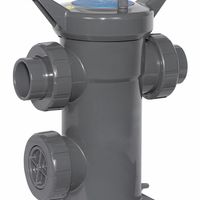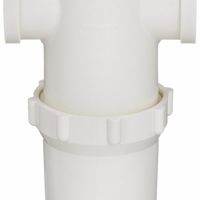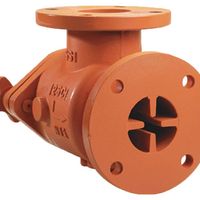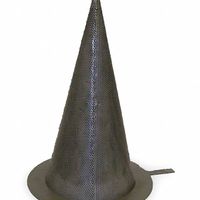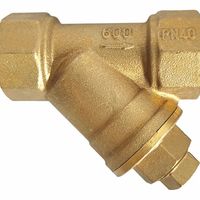Call +(254) 703 030 000 / 751 483 999 / 721 704 777
- Home
- Plumbing
- Water Filtration Purification Systems
- Water Strainers
Frequently Asked Questions
What is the difference between a water strainer and a filter?
A water strainer and a filter both serve the purpose of removing impurities from water, but they differ in design, function, and application.
A water strainer is a device that removes larger particles and debris from water. It typically consists of a mesh or perforated screen that captures solid particles while allowing water to pass through. Strainers are often used in applications where the primary concern is protecting equipment from damage caused by large debris, such as in pipelines, pumps, or irrigation systems. They are generally easier to clean and maintain, as the captured debris can be removed by simply cleaning or replacing the screen.
In contrast, a water filter is designed to remove smaller particles, contaminants, and impurities from water, including sediments, bacteria, chemicals, and other dissolved substances. Filters use various media, such as activated carbon, ceramic, or reverse osmosis membranes, to achieve a higher level of purification. They are commonly used in residential, commercial, and industrial settings to ensure water quality and safety for consumption or specific processes. Filters often require more maintenance and replacement compared to strainers, as the filtering media can become saturated or clogged over time.
In summary, the main difference lies in their purpose and capability: strainers are used for removing larger particles and protecting equipment, while filters are used for purifying water by removing smaller contaminants.
How do I choose the right water strainer for my application?
To choose the right water strainer for your application, consider the following factors:
1. **Type of Strainer**: Determine whether you need a Y-strainer, basket strainer, or T-strainer. Y-strainers are suitable for low-flow applications and can be installed in horizontal or vertical pipelines. Basket strainers are ideal for high-flow systems and provide a larger debris holding capacity. T-strainers are used in applications requiring temporary straining.
2. **Material**: Select a material compatible with the fluid and environmental conditions. Common materials include stainless steel, cast iron, bronze, and plastic. Stainless steel is corrosion-resistant and suitable for various applications, while cast iron is cost-effective for non-corrosive environments.
3. **Mesh Size**: Choose the appropriate mesh size based on the size of particles you need to filter out. Finer mesh sizes capture smaller particles but may require more frequent cleaning.
4. **Flow Rate**: Ensure the strainer can handle the system's flow rate without causing excessive pressure drop. Check the strainer's flow capacity and pressure loss characteristics.
5. **Connection Type**: Match the strainer's connection type (flanged, threaded, or welded) with your existing piping system for compatibility and ease of installation.
6. **Maintenance Requirements**: Consider how easy it is to clean and maintain the strainer. Some designs allow for easy access to the straining element, reducing downtime.
7. **Pressure and Temperature Ratings**: Verify that the strainer can withstand the system's operating pressure and temperature conditions.
8. **Application Specifics**: Consider any specific requirements of your application, such as chemical compatibility, sanitary standards, or space constraints.
By evaluating these factors, you can select a water strainer that effectively meets your application's needs, ensuring efficient operation and longevity.
What are the benefits of using a Y strainer?
A Y strainer is a mechanical device used in pipelines to filter out debris and protect equipment. Its benefits include:
1. **Protection of Equipment**: Y strainers prevent damage to pumps, valves, and other equipment by trapping debris, thus extending their lifespan and reducing maintenance costs.
2. **Versatility**: Suitable for various applications, Y strainers can handle different types of fluids, including water, oil, and gas, making them versatile for industrial, commercial, and residential use.
3. **Compact Design**: Their compact and lightweight design allows for easy installation in tight spaces, making them ideal for systems with limited room.
4. **Cost-Effective**: Y strainers are generally more affordable than other filtration systems, providing an economical solution for protecting pipeline components.
5. **Easy Maintenance**: The strainer can be cleaned without removing it from the pipeline, reducing downtime and maintenance efforts. The screen can be accessed and cleaned by removing the cap or cover.
6. **Durability**: Made from robust materials like stainless steel, cast iron, or bronze, Y strainers are durable and can withstand high pressure and temperature conditions.
7. **Efficiency**: By removing unwanted particles, Y strainers improve the efficiency of the fluid system, ensuring smooth operation and optimal performance.
8. **Pressure Drop Management**: They help in managing pressure drops across the system by maintaining a clean flow path, which is crucial for system efficiency.
9. **Customizable**: Available in various sizes and mesh configurations, Y strainers can be customized to meet specific filtration needs, ensuring optimal performance for different applications.
10. **Corrosion Resistance**: Many Y strainers are designed to resist corrosion, making them suitable for harsh environments and extending their service life.
How often should water strainers be cleaned or maintained?
Water strainers should be cleaned or maintained regularly to ensure optimal performance and prevent blockages. The frequency of cleaning depends on several factors, including the type of system, the quality of the water, and the specific application. Here are some general guidelines:
1. **Residential Use**: For household water systems, strainers should typically be checked and cleaned every 2 to 4 months. If the water source is known to have high sediment levels, more frequent maintenance may be necessary.
2. **Industrial Applications**: In industrial settings, where water strainers are used in processes like cooling, heating, or filtration, they should be inspected and cleaned more frequently, often monthly or even weekly, depending on the system's demands and the quality of the water.
3. **Marine and Boating**: For marine applications, such as on boats, strainers should be checked before each trip and cleaned as needed, especially if operating in waters with high debris or algae content.
4. **Agricultural Use**: In agricultural systems, where water is used for irrigation, strainers should be inspected and cleaned at least once a month, or more often during peak irrigation periods.
5. **High Sediment Areas**: In areas with high sediment or debris in the water, strainers may need to be cleaned weekly or even daily to prevent clogging and ensure efficient operation.
Regular maintenance involves removing the strainer, cleaning the mesh or screen, and checking for any signs of wear or damage. It's also important to follow the manufacturer's recommendations for specific maintenance intervals and procedures. Consistent maintenance not only prolongs the life of the strainer but also ensures the efficiency and reliability of the entire water system.
What materials are best for water strainers in corrosive environments?
In corrosive environments, selecting the right materials for water strainers is crucial to ensure durability and functionality. The best materials for water strainers in such conditions include:
1. **Stainless Steel (316 and 316L):** Known for its excellent corrosion resistance, especially in chloride-rich environments, 316 and 316L stainless steel are ideal for water strainers. They offer high resistance to pitting and crevice corrosion, making them suitable for marine and industrial applications.
2. **Duplex Stainless Steel:** This material combines the benefits of austenitic and ferritic stainless steels, providing superior strength and corrosion resistance. It is particularly effective in environments with high chloride concentrations and is less prone to stress corrosion cracking.
3. **Titanium:** Titanium is highly resistant to corrosion in seawater and other aggressive environments. It is lightweight yet strong, making it an excellent choice for critical applications where both corrosion resistance and strength are required.
4. **Hastelloy:** This nickel-based alloy offers exceptional resistance to a wide range of corrosive media, including strong acids and seawater. Hastelloy is suitable for extreme environments where other materials might fail.
5. **Monel:** Composed primarily of nickel and copper, Monel is highly resistant to corrosion, especially in saltwater and acidic conditions. It is often used in marine applications due to its durability and resistance to biofouling.
6. **Plastic and Composite Materials:** High-performance plastics like PVDF (Polyvinylidene fluoride) and composites can be used in less demanding corrosive environments. They offer good chemical resistance and are lightweight, though they may not provide the same strength as metal alloys.
Choosing the right material depends on the specific environmental conditions, including temperature, pressure, and the presence of specific corrosive agents. Proper material selection ensures the longevity and efficiency of water strainers in corrosive environments.
Can water strainers handle hot liquids?
Water strainers can handle hot liquids, but their ability to do so depends on the material and design of the strainer. Strainers made from stainless steel or high-temperature resistant plastics are generally suitable for hot liquids, as these materials can withstand high temperatures without degrading or losing structural integrity. Stainless steel is particularly favored for its durability and resistance to corrosion, making it ideal for both hot and cold liquids.
On the other hand, strainers made from lower-grade plastics or materials not designed for high temperatures may warp, melt, or release harmful chemicals when exposed to hot liquids. It's crucial to check the manufacturer's specifications to ensure the strainer is rated for the temperature of the liquid you intend to use it with.
In industrial or commercial settings, strainers are often used in systems that handle hot liquids, such as in food processing or chemical manufacturing. These strainers are specifically designed to cope with high temperatures and pressures, often featuring reinforced structures and materials that can endure extreme conditions.
For household use, kitchen strainers are typically designed to handle the temperatures of boiling water, such as when straining pasta or vegetables. However, it's always advisable to verify the temperature tolerance of the strainer to avoid damage or safety hazards.
In summary, while many water strainers can handle hot liquids, it is essential to ensure that the specific strainer you are using is made from materials and designed in a way that can safely accommodate the temperature of the liquid in question. Always refer to the product guidelines for temperature limits to ensure safe and effective use.
What is the maximum particle size that a water strainer can remove?
The maximum particle size that a water strainer can remove depends on the mesh size or perforation size of the strainer. Strainers are designed to remove larger particles from fluids, and their effectiveness is determined by the size of the openings in the straining element.
Mesh size is typically measured in microns or by the number of openings per linear inch. For example, a 100-mesh strainer has 100 openings per inch, and the size of these openings determines the maximum particle size that can be removed. The higher the mesh number, the smaller the openings, and thus, the smaller the particles that can be filtered out.
Common strainer mesh sizes range from 20 mesh (with openings of about 840 microns) to 200 mesh (with openings of about 74 microns). Therefore, a 20-mesh strainer can remove particles larger than 840 microns, while a 200-mesh strainer can remove particles larger than 74 microns.
For applications requiring the removal of very fine particles, strainers with even smaller mesh sizes or specialized filters may be used. However, it's important to note that as the mesh size decreases, the strainer may become more prone to clogging and require more frequent maintenance.
In summary, the maximum particle size a water strainer can remove is determined by its mesh size, with common strainers capable of removing particles ranging from approximately 74 to 840 microns, depending on the specific application and requirements.
